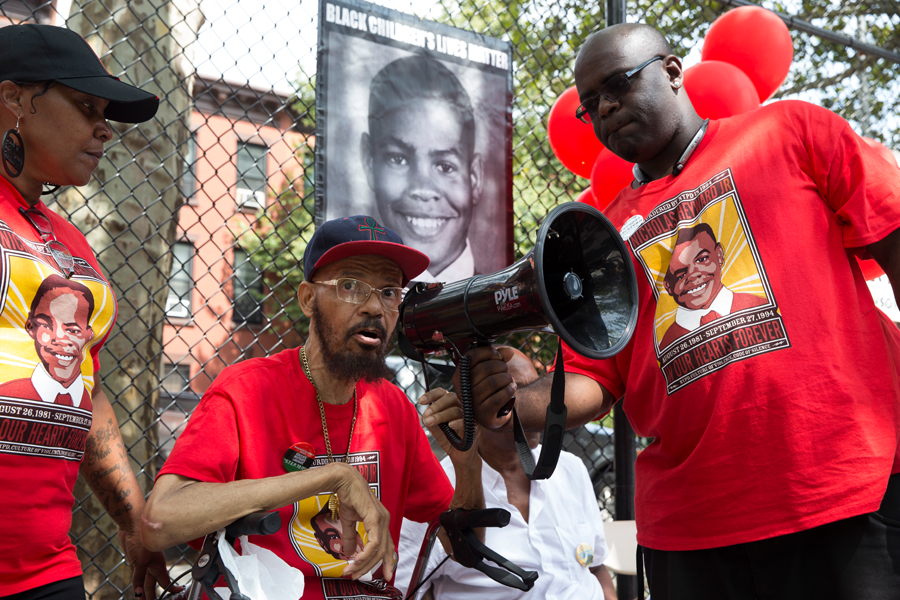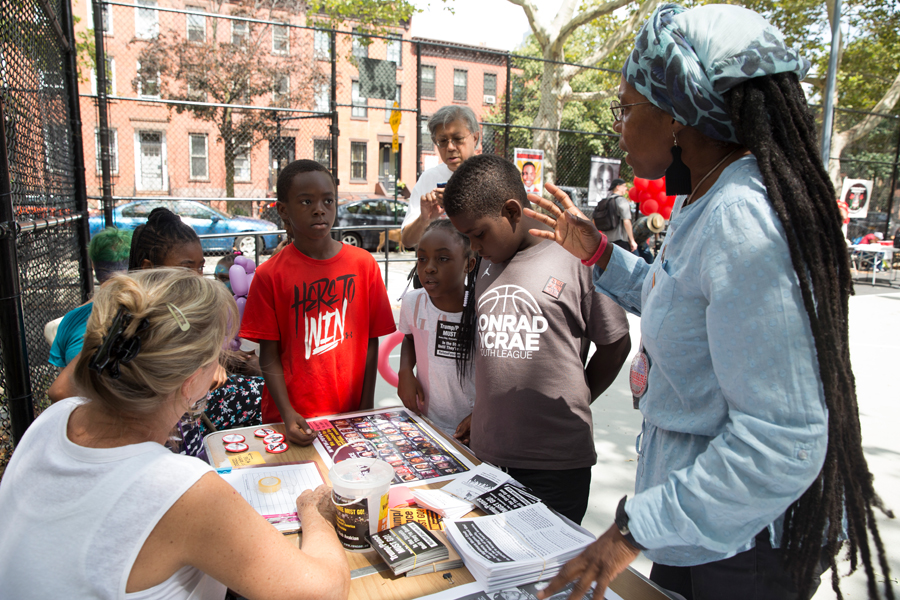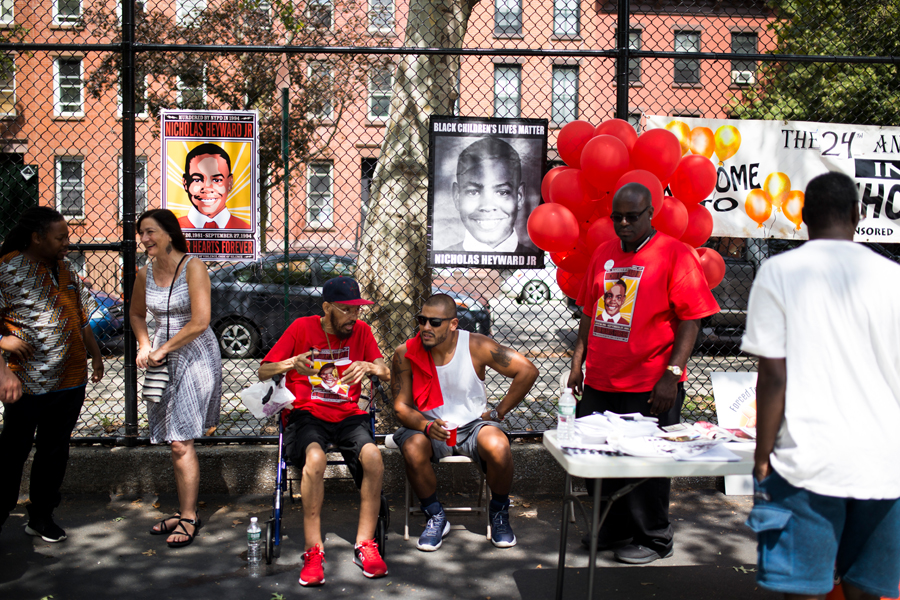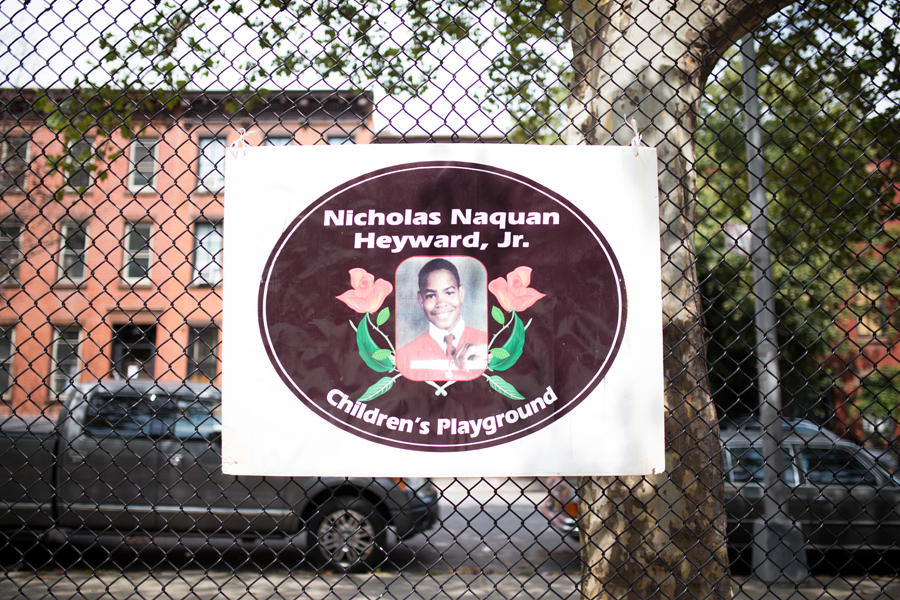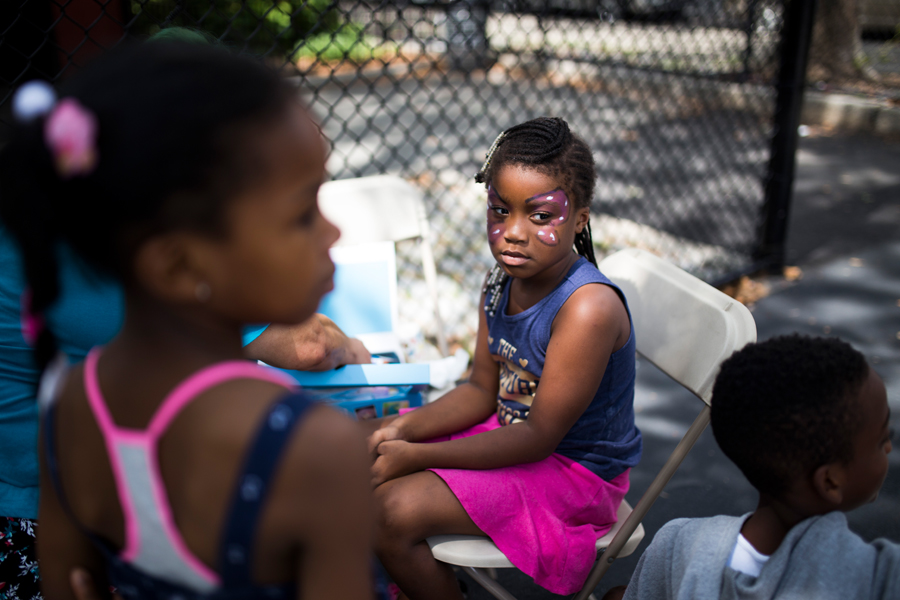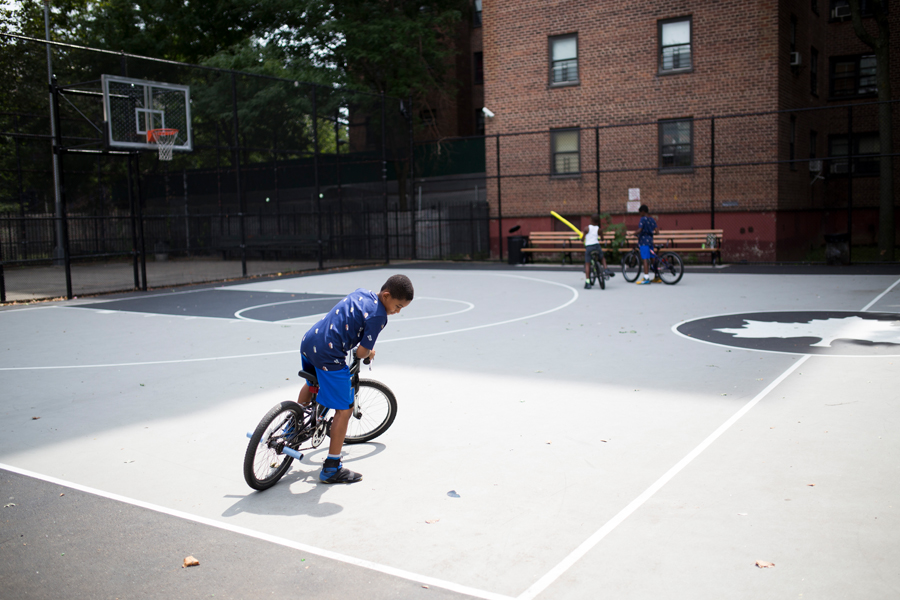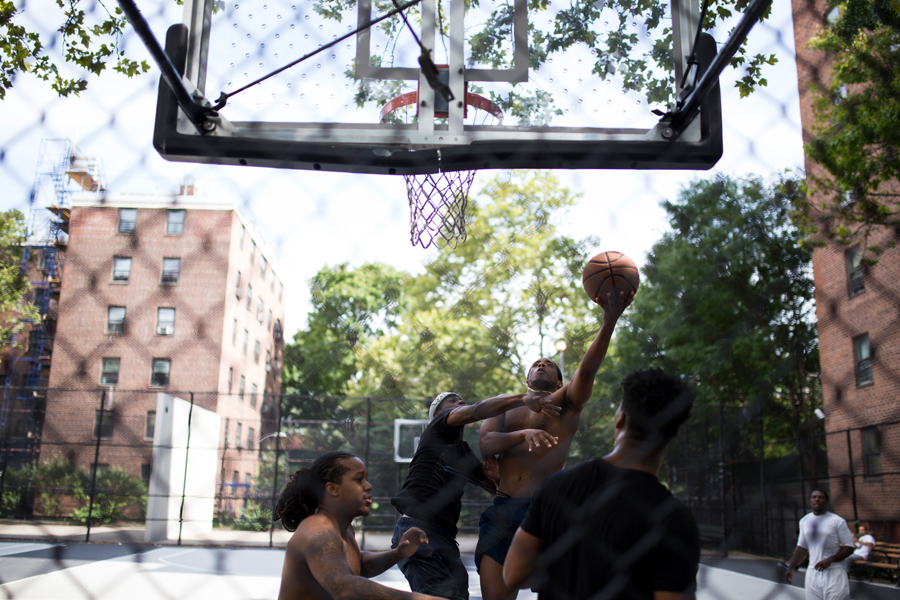NEW YORK — The children who gathered around the pictures of the dead were curious.
Right next to them a man was twisting balloons into funny shapes beneath the basketball hoop, and on their other side a woman set up a chair to do face paintings of rainbows and animals. But these girls and boys were drawn to a protester’s rickety foldout table covered with stacks of pamphlets and fliers and a black-and-white poster covered with pictures.
 One girl dragged her finger across the poster of faces and names of people killed by the New York City Police Department and landed on a young man. She turned her head up to a nearby adult and asked a question.
One girl dragged her finger across the poster of faces and names of people killed by the New York City Police Department and landed on a young man. She turned her head up to a nearby adult and asked a question.
“Who is this?” she asked.
“His name is Mohammed,” answered Sister Shirley, an activist at the booth. “Mohamed Bah.”
“He was sick and his mom called 911 for an ambulance. Instead the cops came, six of them, and they shot him to death,” the woman replied dispassionately. She spoke with a tone of a teacher delivering a lesson. “He was shot seven times. And they wouldn’t even let his mother see him.”
24th anniversary
The woman, an activist who goes by the name Sister Shirley From the Forgotten Borough of Staten Island, began the hard lesson in police violence by explaining why everyone had gathered at the Nicholas Heyward Jr. playground and basketball courts in Brooklyn that Saturday. She explained that today would have been his birthday if he were still alive and that they were commemorating his life and death with the 24th Annual Day of Remembrance.
Sister Shirley said she did not have to make the children come over and learn.
“I didn’t have to force them,” she said. “They came up and started asking questions. ‘Who is this? What happened to that person?’ It’s a shame that children have to see this and then learn that nobody has ever done a damn thing about it.”
On Sept. 27, 1994, Heyward Jr. was shot and killed while playing cops-and-robbers with his friends in the stairwell of one of the buildings in the Gowanus Houses in Brooklyn. He was holding a plastic gun, a miniature version of a cowboy’s pump action rifle with a novelty orange nozzle and strings hanging from it. Brian George, a housing officer with the NYPD, shot and killed him. Heyward Jr. was 13. Had he not been killed, he would have turned 37 last Saturday.
Self-defense claimed
Instead, the party was to remember him, celebrate his short life and remind the city that he still has not, in his family’s eyes and in the eyes of the small clutch of civil rights activists in attendance, received justice for what they insist was not a justifiable shooting. In the decades since the shooting, Nicholas’ father, Nicholas Heyward Sr., has fought for justice — sometimes on the streets through protest, sometimes like last Saturday in the playground with parties.
And he sought it in the halls of justice when he convinced the Brooklyn district attorney’s office to re-examine the case in 2015.
For more information on Racial-Ethnic Fairness, go to JJIE Resource Hub | Racial-Ethnic Fairness
After a yearlong probe by the office’s Civil Rights Bureau, the DA’s office reached the same conclusion in 2016 as had Charles Hynes, the district attorney at the time of the fatal shooting. The report ruled that the officer acted in self-defense when he fired a single shot that killed Heyward Jr. and that there would be no charges filed in the case.
Hynes had ruled that Officer Brian George fired a single shot in self-defense during a "tragic" encounter with Nicholas Heyward Jr. in a Gowanus Houses stairwell.
In 2016 the office released a statement that said: "Based on the totality of the evidence, we have concluded that the shooting did not rise to the level of a criminal act. Officer George reasonably believed that his life was in danger when faced with a realistic-looking gun aimed at him.”
Since then, the family has been in a protracted legal fight to get all the documents tied to the probe. For the protesters who are on the frontlines of advocating for police policy reform, the killing of Heyward Jr. is a modern civil rights killing.
Photo Gallery
Inspiration of Heyward Sr.
Anthony Beckford, who noted that he would have been the same age as Heyward Jr., compared the killing to the murder of Emmett Till in the Mississippi Delta in 1955. He noted with sardonic irony that at least in that murder you had a trial, referring to the show trial of Till’s killers who were found not guilty by an all-white jury. They later went on to confess to the killing in a magazine interview.
“All these years and still no justice,” he said, shaking his head dejectedly.
But, Beckford said, he draws inspiration from Nicholas Jr.’s father for his relentless pursuit even as many in the city and the projects where the teenager grew up forget about his legacy.
“It still means everything to him,” Beckford said, noting that Heyward Sr. has been ill over the last year but still has not relented campaigning on behalf of his son. “He’s still fighting for justice.”
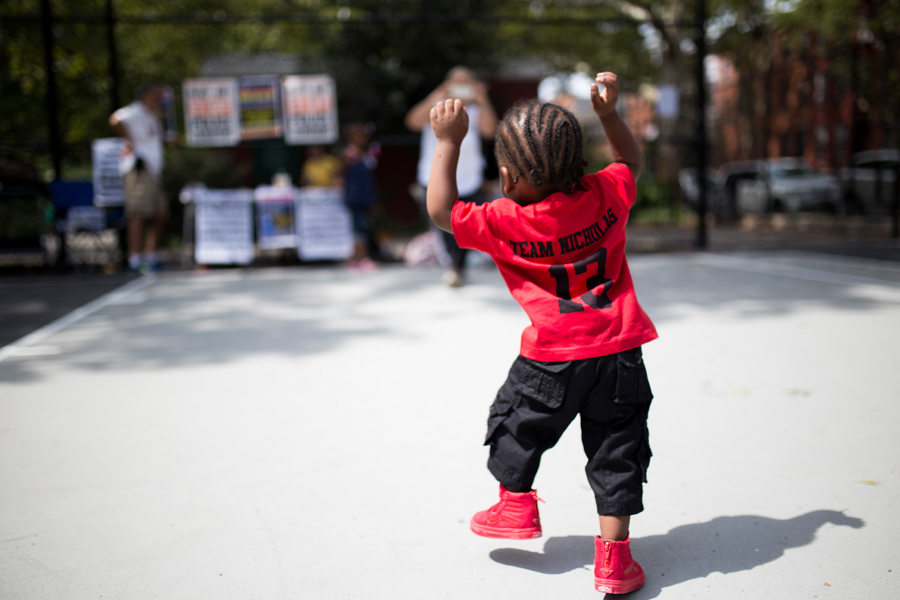
Adonis Heyward, Nicholas Heyward Sr.’s 1-year-old son, plays in the playground.
He pointed to Heyward Sr. who appeared frail sitting on a walker. Nicholas Sr.’s youngest son, Adonis, danced to the explosive horns and thumping base of Ice Cube’s “Good Cop, Bad Cop,” jumping up and down to the beat and eliciting a wan smile from his father.
When Beckford, the head of Brooklyn’s Copwatch Patrol Unit, saw that officers in the courtyard were watching the activities from a distance he became irate.
“That’s an insult on top of an injury,” he said. “This is a no-cop zone.”

Police stand watch just outside the gathering in the Nicholas Naquan Heyward Jr. Park at the Gowanus Houses in Brooklyn.
When asked, the six officers stationed just outside the basketball courts shrugged and refused to answer whether they were there for the Heyward tournament. They made efforts to shield their faces when a photographer attempted to take pictures of them as they stood next to a flier for the event taped to a metal scaffolding.
In 2016, police swarmed the event in what they said at the time was an attempt to prevent violence between nearby housing projects in the Red Hook neighborhood.
No change
Jasper Kerbs, 23, was born a year after Heyward Jr. was killed, but he grew up hearing stories about the young man. He heard that he was studious and thoughtful and enjoyed frolicking with his friends in the playground now named after him. He remembers growing up haunted about the fact that young people could never feel safe around the NYPD when they were patrolling the houses.
“It feels like nothing has changed,” he said. “There are more police here now then there has ever been.”
Heyward Sr. formally kicked off the event shortly after noon. He struggled with a megaphone to address a sparse crowd of young people and activists. Beckford came over and held it up to his mouth.
“OK, OK, people, I’d like to thank those of you out here today. For a day of remembrance for my son,” he said, his voice sounding thin and tinny from the megaphone. “I don’t see much of Gowanus out here,” he continued, then apologized and said he didn’t feel well enough to continue.
Beckford took the megaphone and exhorted other people in the apartment complex to come and show support.
“Gowanus, if you can hear me, I need you to come out,” he said. “We need your support. It could have been you. It could have been your child this happened to.”
Postcards and stickers
With that, the event began. It was a mix of a party atmosphere and a political rally. Donna Heyward, Heyward Jr.’s stepmother, laid out pans of rice and beans and roasted chicken. She had to chase off children who wanted to sneak some before it was time. But just a few stands down from her a booth was set up with postcards addressed to Mayor Bill de Blasio. Next to the stack of postcards were spools of colorful stickers that an attendee could adhere to the postcard and leave to be sent to City Hall.
One read: “Police shouldn’t be the ones disciplining our kids in school.” Another read: “Police should have to tell the public when people die in their custody.”
Nearby, children scampered around the yard. Some of them drawn to the balloon man and face painting artist. Others wandered over to the police reformer’s table, where arguments about the Trump administration and how to best effectively deal with the president were raging, and where Sister Shirley tried her best to field questions about a poster full of dead people, like Nicholas Jr.
One of the children asked her about the fate of the officer who shot him.
“What happened to the cop? Did he get arrested,” she asked.
Sister Shirley pursed her lips and shook her head. The children twisted their face with incredulity. Later in the afternoon, as the basketball games were in full swing, some of the younger children at the event were playing nearby with little plastic cap guns.
“I hope,” a girl said, “The police don’t shoot me.”
While we have you, will you help us keep doing great reporting on juvenile justice?
If you like what we do and want to see more of it, please consider filling out this pledge card. Any amount is appreciated. No kidding, any amount. We need your money, but we also need you.
Here's why: Between Nov. 1 and Dec. 31, 2018, a number of national foundations including The Democracy Fund, The Knight Foundation and The MacArthur Foundation will match every dollar we raise up to $28,000. And, this generous offer extends to signing up new members. If we get 100 new members, we will qualify for a bonus.
So please consider pledging today. We will send a donation link out to you after Nov. 1. Right now, we need your name.
Thank you for supporting the JJIE and the future of journalism.
